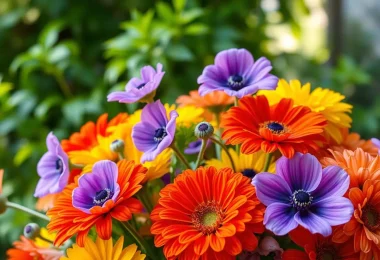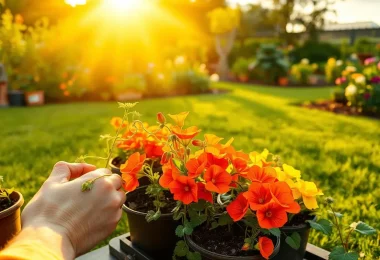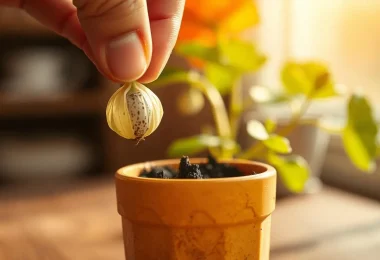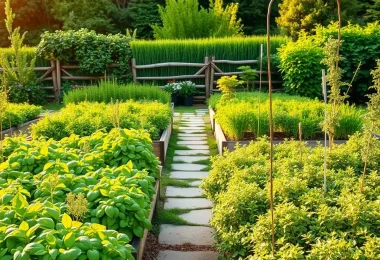A raised bed garden is perfect for those with little space or bad soil. You can control the soil, drainage, and sunlight. This makes it great for gardeners of all levels. This article will teach you how to make your ideal raised bed garden.
In a raised bed, you can make the soil just right for your plants. It’s ideal for growing fruits, veggies, and flowers, even with little space or bad soil. By following this guide, you can make a thriving garden that will give you fresh produce and beautiful flowers for years.
Introduction to Raised Bed Gardening
Raised bed gardening is a popular way to garden. It involves growing plants in a raised bed, often made of wood, stone, or composite materials. This method has many benefits, like better soil, drainage, and easier access. It’s great for both new and experienced gardeners.
Key Takeaways
- Control over soil quality and drainage
- Ideal for small spaces or poor soil quality
- Perfect for growing fruits, vegetables, and flowers
- Improved accessibility for gardeners of all levels
- Increased crop yields and better plant health
- Customizable to fit your specific gardening needs
Understanding the Benefits of Raised Bed Gardening
Raised bed gardening brings many advantages to your gardening journey. It lets you tailor a growing space for your plants. This way, you can control the soil and ensure it drains well, avoiding waterlogged soil and root rot.
With a well-planned raised bed, you can start planting earlier in spring and keep growing into fall. Raised beds can also be made to be easier on your body. For example, waist-high beds help you avoid bending and straining. This is great for gardeners with mobility issues.
When designing your raised bed garden, keep these benefits in mind:
- Improved soil structure and fertility
- Increased drainage and reduced waterlogging
- Extended growing season and improved crop yields
- Ergonomic benefits and reduced physical strain
By focusing on these benefits, you can build a garden that thrives and meets your needs. Raised bed gardening is perfect for both new and experienced gardeners. It’s a great way to elevate your gardening experience.
Essential Planning for Your Raised Bed Garden
Creating a thriving raised bed garden starts with careful planning. You need to think about the garden’s size and location. Also, consider the plants you want to grow. Don’t forget about the frame materials, color scheme, and the look you aim for. Start by brainstorming ideas for raised bed gardens that match your style and needs.
A well-planned raised bed garden can greatly impact your plants’ success. Here are important factors to consider:
- Climate and weather conditions in your area
- Amount of sunlight and water your plants will need
- Type of soil and nutrients required for your plants
- Space and layout of your garden
By planning your raised bed garden well, you can create a beautiful and productive space. It will bring you joy and fresh produce. Look into different ideas for raised bed gardens to find the perfect one for you.
Choosing the Perfect Location for Your Raised Bed
The spot you pick for your raised bed is key to a great garden. Think about the sunlight your garden will get. Most plants need at least 6 hours of direct sunlight daily.
If your plants prefer partial shade, use a trellis to filter the sun. This helps them get the right amount of light.
Also, think about how much space you have. Measure the area for your raised bed and pathways. Leave at least 3 feet between beds for easy access.
Remember, the soil you choose is also important. It affects your plants’ health. So, pick a spot that works well with your soil.
Some key things to think about include:
- Proximity to a water source
- Accessibility for maintenance and harvesting
- Soil quality and drainage
- Surrounding environment, including trees, fences, and other structures
By thinking about these things, you can make a great raised bed garden. It’s a good start for both new and experienced gardeners. With the right spot and soil, your garden will thrive.
Materials for Building a Raised Bed
Choosing the right materials for your raised bed is key. Use sustainable and durable options like cedar or recycled plastic for the frame. This ensures your bed lasts long and supports your design for raised bed garden. A good raised bed garden needs careful planning, including the right raised bed soil mix.
When building a raised bed, the materials matter a lot. Here are some things to think about:
- Type of frame material: cedar, recycled plastic, or wood
- Soil mix: choose a high-quality raised bed soil mix that’s designed for raised beds
- Drainage system: consider the type of gravel or sand to use
- Irrigation system: think about the type of pipes and fittings to use
By picking the right materials and thinking about your plants’ needs, you can make a great raised bed garden. This garden will give you fresh produce for years. Don’t forget to think about the design for raised bed garden and how it affects your plants’ growth and health.
Step-by-Step Guide to Building Your Raised Bed
Building a raised bed is easy with basic tools and materials. First, clear the site and level the ground. This makes a solid base for your garden.
A raised bed garden is perfect for growing your favorite plants. Choose the right materials, like wood or composite, and decide on the bed’s size. The size depends on the space and how many plants you want.
Tools Required
You’ll need a shovel, hammer, and screwdriver to build a raised bed. You might also need a saw or drill, depending on your materials.
Assembly Instructions
To put together the raised bed, follow these steps:
- Assemble the frame using the materials you have chosen
- Add a bottom layer of gravel or sand for drainage
- Fill the bed with a mix of soil and compost
Adding Support Structures
Think about adding trellises or stakes for extra plant support. This helps your plants grow upright and produce more fruit.
Creating the Perfect Raised Bed Soil Mix
To make sure your plants thrive, you need a balanced raised bed soil mix. It should drain well, be fertile, and full of organic matter. Mix topsoil, compost, and perlite or vermiculite for the best results. The perfect raised bed soil mix varies by plant, so think about what they need.
When making your raised bed soil mix, keep these points in mind:
- pH level: Adjust the pH of your raised bed soil to match your plants’ needs.
- Organic matter: Compost or other organic materials boost fertility and structure.
- Drainage: Perlite or vermiculite help prevent waterlogged soil.
Creating a balanced raised bed soil mix gives your plants a great start. Tailor your mix to your plants’ needs. Feel free to try new things and adjust your recipe as you go.
Irrigation Systems for Raised Beds
For a raised bed garden, a good irrigation system is key. It keeps your plants healthy and productive. A drip irrigation system is great because it waters the roots directly. This cuts down on water lost to evaporation and runoff.
When designing your raised bed garden, think about how much water your plants need. Some plants need more water, while others prefer dry soil. A well-planned irrigation system makes your garden thrive with little upkeep.
- Drip irrigation systems
- Soaker hoses
- Watering cans
- Mulch and cover crops to reduce evaporation and retain moisture
Adding these ideas to your garden design makes it beautiful and water-efficient. Your garden will be easy to care for.
Plant Selection and Layout Planning
Creating a thriving raised bed in garden starts with choosing the right plants and planning their layout. First, think about your plants’ climate, soil, and sunlight needs. Also, consider how big they’ll grow and leave enough space for them to spread out. This helps you design a raised bed for plants that will do well.
A good raised bed mixes annuals and perennials for a lively look. Think about what each plant needs, like sunlight, water, and nutrients. Here are key things to think about when planning your raised bed in garden:
- Climate and soil type
- Sunlight and shade requirements
- Water and nutrient needs
- Mature plant size and growth habits
By picking the right plants and planning their layout, you can make a raised bed that’s both productive and beautiful. Make sure to think about how to make a raised bed for plants that fits your climate and soil.
Companion Planting in Raised Beds
Companion planting is a method used in raised bed gardens. It helps plants grow better, stay healthy, and fight pests. For instance, marigolds can keep nematodes away from tomatoes. Basil and lettuce taste better when grown together.
When gardening in raised beds, think about what each plant needs. They require sunlight, water, and nutrients. A good raised bed soil mix provides these essentials. It’s also customizable for each plant’s needs, perfect for companion planting.
Compatible Plant Combinations
- Tomatoes and basil: improve flavor and deter pests
- Marigolds and carrots: deter nematodes and other pests
- Lettuce and radishes: improve growth and reduce soil compaction
Spacing Guidelines
When planting together, make sure plants have enough space. This allows for growth and air flow. A well-planned raised bed garden fights pests and improves soil health. It’s great for gardeners of all levels.
Seasonal Maintenance of Your Raised Bed
To keep your raised bed garden thriving, seasonal maintenance is key. A well-designed raised bed garden needs regular care. This ensures your plants stay healthy and successful.
When designing your raised bed garden, think about seasonal maintenance. This helps you plan for each season. For instance, in spring, add fresh soil and fertilizers. In summer, focus on watering and feeding your plants well.
- Adding a layer of compost or mulch in the fall to protect your soil and retain moisture
- Planting new crops in the spring to take advantage of the warmer weather
- Controlling weeds and pests during the summer to prevent damage to your plants
- Protecting your raised bed from extreme weather conditions, such as frost or heavy rainfall
By following these seasonal maintenance tasks, your raised bed garden will stay healthy and productive. You’ll enjoy a bountiful harvest from your garden.
Common Challenges and Solutions
Keeping a raised bed garden can face several hurdles, like pests, diseases, and soil nutrient issues. To tackle these, try integrated pest management. This includes crop rotation and companion planting to lower pest and disease risks. Also, think about how to handle specific problems like deer or rabbits in your garden.
A good raised bed soil mix can solve many of these problems. Using a mix made for raised beds can improve soil quality and prevent erosion. This creates a better environment for your plants to grow well.
- Regularly check the raised bed soil for pests or diseases.
- Use physical barriers to keep deer or rabbits away from your plants.
- Rotate crops to break disease and pest cycles.
- Use companion planting to boost your garden’s health.
Knowing these challenges and acting early can make your raised bed garden flourish. Choose a top-notch raised bed soil mix. Also, pick a spot and design your garden with your plants’ needs in mind.
Advanced Raised Bed Gardening Techniques
For those who love gardening, taking their raised bed to the next level is thrilling. You can do this by using advanced techniques like vertical growing and season extension. These methods help your raised bed flourish, boosting yields and plant health.
Some key techniques to explore include:
- Vertical growing using trellises or arbors to maximize space
- Season extension strategies, such as cold frames or hoop houses, to extend the growing season
- Implementing support structures to meet the specific needs of your plants
These advanced techniques can make your garden more productive and healthy. Whether you’re starting a new raised bed or looking to improve your existing one, these methods will elevate your gardening game.
| Technique | Description |
|---|---|
| Vertical Growing | Using trellises or arbors to maximize space and increase yields |
| Season Extension | Implementing cold frames or hoop houses to extend the growing season |
By using these advanced techniques, you can create a garden that’s not just productive but also beautiful. It will meet your needs and exceed your expectations.
Design Ideas for Stylish Raised Beds
Creating a raised bed garden means thinking about how it looks. A well-designed garden can make your yard look better and feel welcoming. Choose plants, materials, and decorations that fit your garden’s style.
Think about what your garden needs, like paths, places to sit, and decorations. Here are some ideas to get you started:
- Use plants with different textures and colors to make your garden interesting.
- Add things like trellises, arbors, or sculptures to make your garden unique.
- Consider raised beds with seating or storage for a functional outdoor space.
By using these ideas, you can make a beautiful and useful garden. Choose a design that shows your style and fits your yard. With creativity, your raised bed garden can become a stunning part of your yard.
Whether you’re new to gardening or have experience, a well-designed raised bed garden is great. Think about your garden’s style and what your plants need. This way, you can create a garden that’s both beautiful and thriving.
| Design Element | Description |
|---|---|
| Pathways | Use gravel, stone, or brick to create pathways that lead to different areas of your garden. |
| Seating Areas | Incorporate benches, chairs, or other seating options to create comfortable spaces to relax and enjoy your garden. |
| Decorative Features | Use sculptures, water features, or other decorative elements to add personality and visual interest to your garden. |
Maximizing Yield in Your Raised Bed Garden
To get the most out of your raised bed, it’s key to use techniques that help plants grow well. The quality of your raised bed soil mix is crucial. It should be full of nutrients and drain well. A good raised bed soil makes your plants flourish, leading to a big harvest from your raised bed.
Consider using succession planting. This means planting small batches of seeds every few weeks. It keeps your raised bed space used well and your soil productive. Crop rotation is also helpful. It involves changing where you plant to avoid depleting the soil of certain nutrients.
- Increased productivity
- Improved plant quality
- Reduced waste and efficient use of space
By using these strategies and a top-notch raised bed soil mix, you can make your raised bed a productive spot. It will give you a steady supply of fresh produce.
Conclusion: Growing Success with Your Raised Bed Garden
Raised bed gardening is a rewarding way to grow many plants. By planning and maintaining your garden, you get many benefits. These include better soil, drainage, and a longer growing season.
Success in raised bed gardening comes from paying attention to details. Choose the right spot, materials, and soil mix. With good care, your garden will flourish, giving you fresh produce and satisfaction.
Keep improving your gardening skills by trying new things. Use vertical growing and extend the season. This will help you get more from your garden all year.
The real joy of gardening is the connection with your plants and the land. Enjoy the journey, celebrate your wins, and learn from setbacks. This is how you truly enjoy a thriving garden.
FAQ
What are the benefits of raised bed gardening?
Raised bed gardening has many advantages. It lets you control the soil and drainage better. This means your plants grow healthier and stronger.
It also helps prevent waterlogged soil, which can harm your plants. Plus, raised beds are waist-high, making gardening easier on your back and knees.
How do I choose the perfect location for my raised bed?
Pick a spot that gets enough sunlight for your plants. Also, think about how easy it is to get to and water. Make sure it’s not too close to trees or fences.
What materials should I use to build a raised bed?
Use strong, eco-friendly materials like cedar or recycled plastic for the frame. Choose a good soil mix for raised beds. Think about drainage and irrigation systems too.
Consider what plants you’ll grow and their soil needs.
How do I create the perfect raised bed soil mix?
A great soil mix drains well, is fertile, and has lots of organic matter. Mix topsoil, compost, and perlite or vermiculite. Add nutrients and adjust the pH for your plants.
What are some common challenges in raised bed gardening, and how can I address them?
Pests, diseases, and nutrient issues are common. Use methods like crop rotation and companion planting to fight pests and diseases. Plan for challenges like deer or rabbits.
Remember, raised beds improve soil quality and reduce erosion.









